X-Fi and the Elite Pro: SoundBlaster's Return to Greatness
by Derek Wilson on August 30, 2005 11:59 AM EST- Posted in
- Smartphones
- Mobile
Performance and Quality: Game Tests
For these tests, we will be looking at RightMark 3DSound 2.0 and Battlefield 2. With the possibility of twice the number of voices supported by Audigy, we can't do a direct comparison at some points. However, we will see how much impact going from 62 to 127 voices can have.Our test system included these components:
NVIDIA nForce 4 based motherboard
AMD Athlon 64 FX-55
1GB DDR400 2:2:2:8 RAM
NVIDIA GeForce 7800 GTX
120GB Seagate 7200.7 HD
Our RightMark tests show that the Audigy 4 Pro uses less CPU power per setting than the X-Fi. This was a little confusing at first, but we have our thoughts on why this happens. It seems to make sense to us that the X-Fi driver is more complicated than the Audigy driver. We therefore see slightly lower performance from the X-Fi card. With the X-Fi being brand new, driver improvements could also change the performance picture over time.
This performance issue should be different on the higher end X-Fi cards with games that support X-RAM. Unfortunately, we can't test this yet as no games we looked at have this ability. Storing uncompressed audio and not needing to run an MP3 or Ogg decoder in the background would help to significantly lighten the CPU load on most games. Note also how CPU usage increases nearly linearly with the number of voices used.
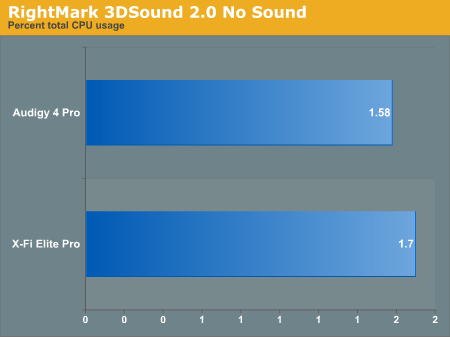
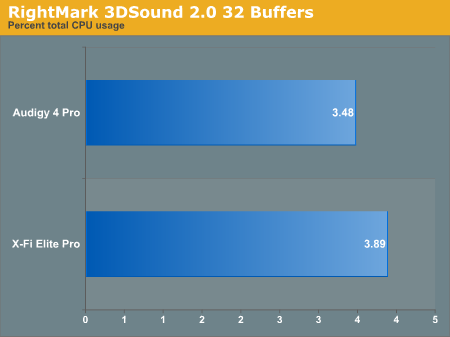
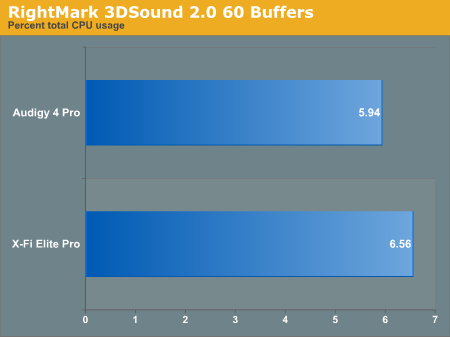
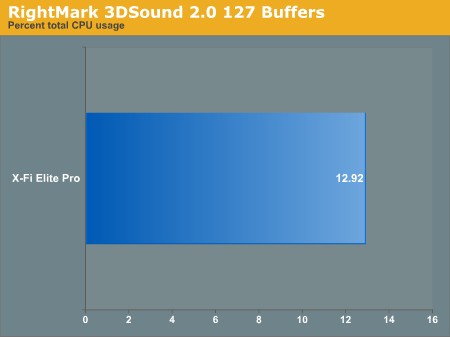
For Battlefield 2, we ran our usual test at medium quality settings at 1024x768. The Ultra High quality option in Battlefield 2 is only accessible with an X-Fi card (which likely means it employs more than 62 voices). As we can see, BF2 performance is consistent with our RightMark numbers. The X-Fi gives us just a little lower performance than the Audigy. It is nice to see that going from High Quality to Ultra High Quality on the X-Fi doesn't incur a significant performance penalty though.
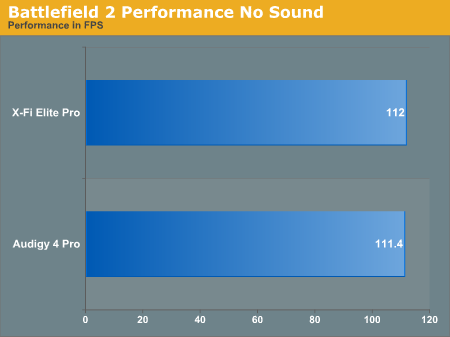

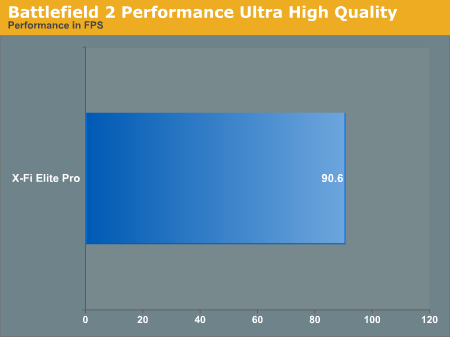










110 Comments
View All Comments
JNo - Thursday, September 1, 2005 - link
In fact, if Anandtech could do a review of the HDA X-Mystique 7.1 it'd be appreciated as I've heard quite a few good things about this card, not least its reasonable price point and dolby digital live output.By the way, on a separate note, for all the people here giving anandtech grief, people should look at more than just one site before making informed purchasing decisions and anandtech did much better than tomshardware which was extremely partisan. Also, I would like to use and trust dedicated sound sites like www.3Dsoundsurge.com but unfortunately they are often too slow in reviewing new hardware...
DerekWilson - Tuesday, August 30, 2005 - link
you can output sound digitally ... dolby sources (DVDs) can be output to a reciever, and audio can be output via SPDIF to a reciver as well ...What you can't do is take a source that's not already dolby (like music, games and the like), encode it to dolby, and then send it to a reciver.
Lwood - Tuesday, August 30, 2005 - link
I found this on the ALSA mailing list (http://www.gossamer-threads.com/lists/linux/kernel...">http://www.gossamer-threads.com/lists/linux/kernel...:"We are not going to get any support from Creative for the X-Fi chip.
We do not get support from Creative for any Creative chip that has a DSP
in it."
It looks like we won't see a Linux driver for the X-Fi anytime soon... :-(
sprockkets - Tuesday, August 30, 2005 - link
Oh well, even nVidia's soundstorm worked in linux, and with the 5.1 encoding out.Reflex - Tuesday, August 30, 2005 - link
I've had these cards in my lab and all I can say is that this is the first time I've ever really doubted Anandtech's credibility. This reads like a spiced up piece of PR from Creative, and subjective listening would not put this as the best consumer audio solution as so prominently stated on the first page of the review.Derek - What the hell is going on here? You don't even include any results from competing products to make such a statement. The war was over before a shot was fired is the impression this review gives. The fact that Creative finally has a card to match the specs that otehr cards have had for three years now makes it a 'revolution'? Sorry, I have been working with these cards for months now and they definatly are nothing special. Just expensive.
flexy - Tuesday, August 30, 2005 - link
100% agree...tried to keep my complaints back, tho.Btw. nice nick :)
DerekWilson - Tuesday, August 30, 2005 - link
Hello,We will be looking at more cards, and including an envy24 based solution is something that we intend to do in the future.
We do include a result from a competing solution -- the Gina 3G is a pro audio card which has excellent audio quality. The Elite Pro is closer to a pro audio product in the component selection and construction.
envy24 based consumer products don't score as well as the Gina 3G from what we have seen. Granted we do have to test this for ourselves, but we would certainly expect the Gina 3G to outperform something from Terratec or M-Audio.
That being said, the X-Fi outperforms the Gina 3G in just about ever test we ran.
It is very difficult to subjectively compare audio between cards. There have been some cases (the audigy line) where there was a very clear problem with the aural experience. With the X-Fi line, we can no longer say that we can hear problems with the audio.
We spent days listening to this card, the Gina, and the Audigy 4. We frankly disagree with the statement that subjective listening does not put this card on par with the best audio solutions out there. We found no reason in our subjective listening tests to conclude otherwise.
On top of that, after simply listening to the card for days, we ran the RMAA tests. These tests showed clearly that not only was the card void of any issues, but that the quality of the output was much closer to the source than any other card we tested. These two points add up to the conclusion you disagree with.
And as we said, if this card performs better than the Gina 3G and the Gina performs better than consumer level envy24 parts, it stands to reason that the X-Fi would outperform just about everything but a LynxTWO ... and even then we would need to run some tests of our own ...
The big problem is that at these incredibly low noise levels, high dynamic range, low distortion, good separation, etc... it is very difficult to hear differences in the audio. To the average person, the audigy 4 Pro, Gina 3G, and X-Fi will sound exactly the same. To a hardcore audiophile, we wouldn't doubt it if the X-Fi won their hearts. The X-Fi (in spite of its features) can provide a very true-to-the-source signal with less coloration than all but the best pro audio cards out there.
For musicians, the high quality provides a better platform for work than the rest of the pack -- unless, of course, balance audio is desired.
Show me a consumer audio card that matches the specs of the X-Fi ... From the tests other people have performed on the LynxTwo B at 16-bit/44.1kHz (the unofficial standard in PC audio quality), the X-Fi posts http://audio.rightmark.org/test/lynx-two-b-1644.ht...">better numbers in every category but frequency response (and it's darn close in that area)...
The high end components used do not make the X-Fi Elite Pro "nothing special" ... They make it nothing most people will need. And certainly, between this and other products that use good quality components, most people won't notice much (if any) difference.
We very much agree that the card is too expensive. And please rest assured that we will be comparing this card to an evny24 based solution -- and hopefully a lynxtwo -- in the future.
Thanks for the feedback,
Derek Wilson
yacoub - Wednesday, August 31, 2005 - link
Look into the BlueGears X-Mystique. It's pretty much the best PC soundcard available at a reasonable price right now - and it's not Creative so there's no assorted bloatware to install.Reflex - Tuesday, August 30, 2005 - link
Derek -I am not trying to bash you here, however you have to understand that when you start an article by proclaiming something the best in its class, but then your test does not include the other solutions in the class at all, that things seem fishy.
I work with audio devices for a living. I've worked with the X-Fi since it was a prototype(as have a couple dozen other people in my lab). Certainly it is an improvement over previous Creative efforts, and at first we were a bit wowed by the paper specs and proposal. However after working closely with it for months, I honestly can say that no one here feels its anything special. Perhaps some of that is the novelty wearing off, but in any ad-hoc test with someone who hadn't heard it before, they could rarely tell the difference between it and an Audigy, and the M-Audio Revolution generally was said to produce clearer sound. Not that our tests were scientific or anything, we weren't trying to write articles for publication.
I'd really suggest some blind tests with a variety of content. I think you may be suprised to find that while for MP3's the X-Fi sounds good, for CD's and especially SACD's the mid-range is poorly reproduced. Make certain you use a wide range of music, and prefferably classical numbers that you know very well.
Something else is you could list what type of speakers/headphones and recievers you are using, if you are testing with something like Klipsch then your credibility would go down considerably for anything but games and action movies, after all the card cannot make up for poor speakers(when measured by reproduction accuracy, not volume).
I would suggest establishing a baseline and going from there. Based on my experience, in the 'consumer' segment the M-Audio Revolution 7.1 is a good baseline, however any baseline that you could compare against would be beneficial to strengthening the credibility of the review. Granted anything audio is subjective, but when you say something is 'better' you need to at least be able to point to some specific reasons as to why.
And finally, the section that read like Creative marketing PR was your explanation of their audio architecture. There is nothing inherantly 'better' about the approach Creative is taking, it is simply different, there are both advantages and drawbacks. Furthermore, while they make the product seem like the 'next generation of audio' no one has managed to get a commitment from them to support the upcoming Windows Audio Architecture that will be a part of Vista, without that support they will be behind several others. Their lack of support for Linux is also a drawback for many.
Thank you for the effort, I hope that this feedback will help you improve your audio reviews in the future. I have read AT since the beginning and rarely doubted what is posted here, there just seemed to be some rather glaring flaws in how this review was handled. At least in my humble opinion.
DerekWilson - Wednesday, August 31, 2005 - link
Thank you very much for the helpful feedback. Some of your suggestions will absolutly make it into future audio reviews.I would tend to disagree with your assesment of Creative's architectural direction. If the intent is to very heavily process many audio streams, then the flexibility and power are helpful. This could be a boon to game designers or electronic musicisans looking for some hefty sample rate or dsp power.
For straight up listening to a single source or recording the architecture is unnecessary.
I agree that windows driver and linux support are drawbacks as well.
We absolutely appreciate and need our readers feedback. Thanks for taking the time.
Derek Wilson